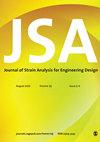Determination of mechanical properties from sharp dynamic indentation
IF 1.8
4区 工程技术
Q3 ENGINEERING, MECHANICAL
Journal of Strain Analysis for Engineering Design
Pub Date : 2021-11-18
DOI:10.1177/03093247211059255
引用次数: 2
Abstract
In this study, a dynamic indentation test method based on the split Hopkinson pressure bar is proposed to obtain the dynamic parameters of Ludwik power law constitutive, namely, Young’s modulus E, strength coefficient K, and strain hardening index n by analyzing dynamic indentation load-indentation depth curve obtained from the theories relating to the Hopkinson pressure bar. The important parameters, namely, loading curvature C and transformation factor δ , are invoked to examine the dynamic indentation response results in a wide range of target material parameters. Finite element calculation results are processed through simulation of dynamic indentation response with broad material parameters. Furthermore, the analytical method is used to fit simulation results to obtain the analytical equations for elastic–plastic parameters and curvature parameters for the subsequent analysis. The analytical equation of forward model to predict dynamic indentation response parameter–loading curvature C of a known material is proposed. Then, the elastic–plastic parameters of unknown materials (according to Ludwik power law) are obtained by substituting the dynamic indentation response parameters into an inverse analytical equation under the two types of half-cone angle indenters. The method is verified by other typical materials, which shows that the dynamic indentation test based on the split Hopkinson pressure bar can obtain sufficient conditions to obtain dynamic mechanical properties of target materials.尖锐动态压痕的机械性能测定
本研究提出了一种基于Hopkinson压杆劈裂的动态压痕试验方法,通过分析Hopkinson压杆相关理论得到的动态压痕载荷-压痕深度曲线,得到Ludwik幂律本构的动态参数杨氏模量E、强度系数K和应变硬化指数n。利用载荷曲率C和转换因子δ等重要参数,对目标材料参数范围内的动态压痕响应结果进行了分析。通过模拟广泛材料参数下的动态压痕响应,对有限元计算结果进行处理。利用解析法对仿真结果进行拟合,得到弹塑性参数和曲率参数的解析方程,供后续分析使用。提出了预测已知材料动态压痕响应参数加载曲率C的正演模型解析方程。然后,将两种半锥角压头下的动态压痕响应参数代入反解析方程,得到未知材料的弹塑性参数(根据Ludwik幂律)。通过其他典型材料对该方法进行验证,表明基于Hopkinson压杆的动态压痕试验可以获得获得目标材料动态力学性能的充分条件。
本文章由计算机程序翻译,如有差异,请以英文原文为准。
求助全文
约1分钟内获得全文
求助全文
来源期刊

Journal of Strain Analysis for Engineering Design
工程技术-材料科学:表征与测试
CiteScore
3.50
自引率
6.20%
发文量
25
审稿时长
>12 weeks
期刊介绍:
The Journal of Strain Analysis for Engineering Design provides a forum for work relating to the measurement and analysis of strain that is appropriate to engineering design and practice.
"Since launching in 1965, The Journal of Strain Analysis has been a collegiate effort, dedicated to providing exemplary service to our authors. We welcome contributions related to analytical, experimental, and numerical techniques for the analysis and/or measurement of stress and/or strain, or studies of relevant material properties and failure modes. Our international Editorial Board contains experts in all of these fields and is keen to encourage papers on novel techniques and innovative applications." Professor Eann Patterson - University of Liverpool, UK
This journal is a member of the Committee on Publication Ethics (COPE).
 求助内容:
求助内容: 应助结果提醒方式:
应助结果提醒方式:


